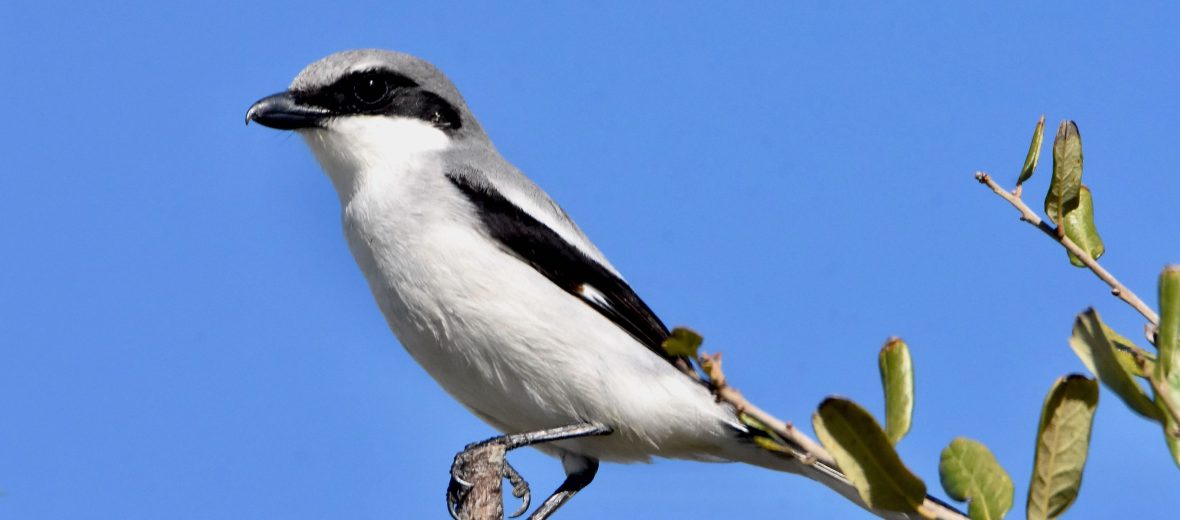
The loggerhead shrike, aka butcherbird, hails from Canada, United States, and Mexico. These are medium sized song birds with a dark secret. Hey, we all have skeletons in our closet. They may be commonly called song birds, but this is just a common term. Their “song” is typically nothing more than a shriek. They face the threats of habitat destruction, at the hands of agriculture, roads, and railroads; hunting; trapping; agricultural pollution; invasive species (and with them disease); and climate change. As a result, they are listed as Near Threatened by the IUCN. Their numbers are also decreasing from an estimated 7,000,000.
First the Stats…
Scientific name: Lanius ludovicianus
Weight: Up to 1.6 ounces
Length: Up to 10 inches
Wingspan: Up to 13 inches
Lifespan: Up to 12 years
Now on to the Facts!
1.) Loggerheads prefer grasslands, open pastures, and favor hawthorn trees and red-cedar trees for nesting.
2.) They like these trees due to the sharp needles and thorns, as they provide protection against some predators.
3.) Shrikes are diurnal (active during the day).
4.) Even though they are considered predatory birds, they are not classified as birds of prey, due to their lack of strong talons.
5.) These birds prefer to perch and scan the area for prey, rather than use hawking (hunting on the wing, aka searching for prey while flying).
But wait, there’s more on the loggerhead shrike!
6.) With their strong beak, they are able to sever the neck of smaller rodents, like mice and young voles, moles, gophers, bats, lizards, and amphibians.
7.) They also prey on insects, arachnids, and small birds.
Did you know…?
As mentioned, these birds have a dark secret. When they find larger prey, they will take it back to their thorny tree of choice and impale the animal on a spike. There they will rip off and consume the flesh, using the spike or barbed wire as an anchor. That escalated quickly, eh?
8.) Their calls include shrill trills, a squeaky whistling, and a guttural warble. When startled, they will sound out a “schgra-a-a” shriek whilst spreading out their tail feathers, to look larger.
9.) Males are more vocal than females.
10.) Loggerhead skrikes are monogamous (mate for life).
But wait, there’s still more on the loggerhead shrike!
11.) Nests are built from grass and twigs.
12.) Females lay up to 8 eggs that hatch in up to 16 days.
Did you know…?
A clever hunting tactic indeed, these birds will tend to hunt insects when the temperatures are lower. The colder temps help to immobilize their prey and make it easier to hunt them.
13.) The name shrike hails from the Old English ‘scrīc’, and is in reference to their shriek-like calls.
14.) A popular food item is the lubber grasshopper. “But these are toxic,” you say. Well, shrikes will impale these grasshoppers on a spike and wait for a few days for the toxins to seep out. Only then will they consume their insect prey.
15.) Males are known to cache food in order to attract a female.
But wait, there’s still a little more on the loggerhead shrike!
16.) Black-billed magpies, crows, and domestic and feral cats hunt skrikes.
17.) The loggerhead shrike tends to perch in open areas. Here they can survey the area for food and better advertise their territory.
18.) There are 33 known species of shrikes, throughout the world.
Now a Short Loggerhead Shrike Video!
This video talks about shrikes, in general.
Be sure to share & comment below! Also, check out the Critter Science YouTube channel. Videos added regularly!
Want to suggest a critter for me to write about? Let me know here.
Think you know a lot about critters? Try your hand at these fun, free quizzes:



